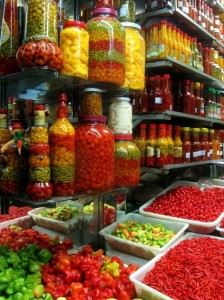
Photo © Michael Sommers.
This week I was passing through Belo Horizonte, capital of Minas Gerais, and I had a couple of hours to kill between my bus from Diamantina and my flight to Salvador. Without thinking twice, I stashed my bags at a gigantic storage locker in the central Rodoviária (bus station) and walked the few busy blocks through the city’s downtown to Belo Horizonte’s Mercado Central.I love the Mercado Central and have visited it every time I’ve had the opportunity to visit “BH” (Mineiros refer to their capital by its initials; pronounced “Bay Agah”). The building, which takes up a full city block is nothing special; but it’s innards, clean, efficient, and extremely organized, are rife with typical Mineiro products that are dazzling in their mineiridade as well as the artistic flair with which they are exhibited; moon-like rounds of Mineiro cheeses, wedged tightly together to create a creamy mosaic; slender bottles packed with a kaleidoscopic arrangements of pimentas in traffic-light reds, greens, and yellows, robust jars filled with glistening preserved fruits, great vats of doce de leite (a favorite sweet made of caramelized milk); thick bricks of guava jelly; sky-high shelves lined with glittering bottles of cachaça…
The sight of so much edible splendor is a serious appetite activator.The sight of so much edible splendor is a serious appetite activator. Fortunately, a significant part of the market is devoted to bars and stalls serving food. My favorites are the white-tiled bars such as Bar da Lora and Bar Valadares where enthusiastic barmen (and women) stand right upon the counter, brandishing icy cold bottles of beer in order to reel in customers (which always hooks me). These bars possess steaming hot griddles onto which are tossed heaps of finely sliced figado (liver), tangles of onions, and chopped jade rounds of jiló, an oval-shaped green fruit, originally from West Africa, whose bitter tang perfectly complements the liver’s richness, the onion’s sweetness, and the beer’s maltiness. Figado com jiló is the market’s signature dish, but you can easily substitute the liver for sliced beef.
Belo Horizonte’s Mercado Central is only one of many enticing municipal markets that serve as cultural and culinary touchstones in Brazil’s state capitals. Here is a quartet of others that shouldn’t be missed:
Mercado Municipal of São Paulo: Known affectionately by Paulistanos as the “Mercadão” (Big Market), this vast belle époque food hall, featuring stained-glass windows depicting agricultural activities is a major mecca of the city’s restaurateurs and foodies. Each day, over 1,000 tons of fresh produce and delicacies arrive from all over Brazil and the world. To satisfy hunger pangs, brave the lines at the Hocca Bar whose pastéis de bacalhau (deep-fried pastries filled with salted cod) have been a favorite snack since 1952 or sink your teeth into one of the mortadela sandwiches served at Bar do Mané.
Mercado Público of Porto Alegre: Completed in 1869, the grand, biscuit-colored neoclassical building that houses the gaucho capital’s main market has an interesting (and very well organized) array of stalls proferring food, wine, cookware, and handicrafts from all over Rio Grande do Sul. Be sure to check out those selling religious objects used in Afro-Brazilian Umbanda rituals as well as the umpteen varieties of Gaúchos’ bitter and beloved erva maté used to make chimarrão , the ubiquitous hot potion served in hollowed-out, polished cuias (gourds). Stop for an icy chope (draft beer) at Naval or an icy suco (juice) or sorvete (ice cream) at Banca 40, which has been selling homemade ice creams for over 50 years.
Feira de São Joaquim of Salvador: The Bahian capital’s oldest and biggest outdoor market is not for the faint of heart. Its labyrinthine lanes are riddled with potholes, puddles and rotting fruit, and you’re always in danger of being run over by a wheelbarrow full of fragrant siriguelas or umbus. If you’re not a vegetarian, the gory meat section will make you contemplate the possibility. Not geared towards tourism, the market is an adventure. The most interesting section is devoted to Candomblé artifacts: fistfuls of brightly colored beads associated with different orixás, fragrant leaves for sacred baths, and ceramic dishes for food and other offerings. Skip breakfast and opt for a early morning plate of feijoada or a glass of caldo de mocotó (calf’s foot broth) at the new barracas – (the market is currently undergoing a massive renovation) – scattered beneath a giant mango tree.
Mercado Ver-o-Peso of Belém: Synonymous with Pará’s capital is this chaotic and colorful riverside market, whose main cast iron structure, topped with neo-Gothic towers, was imported from Scotland in the late 19th century. For over 300 years, boats have sailed down the Amazon from the depths of the rainforest to unload their exotic wares here. Aside from the gorgeous jumble of fruits, fish, spices, and ceramics, one of the most compelling sections is devoted to indigenous herbal remedies that will fix whatever ails you – physically or spiritually. Cures range from powdered vulture’s liver (great for a hangover) to the bottled genitalia of botos (pink river dolphins), said to be a foolproof love potion. For sustenance, there’s no shortage of barracas hawking local delicacies such as tacacá (a broth made of shrimp and tucupi, a thick yellow liquid extracted from the roots of the manioc plant) and fried river fish accompanied by açai (the energy-giving Amazonian wonderberry).